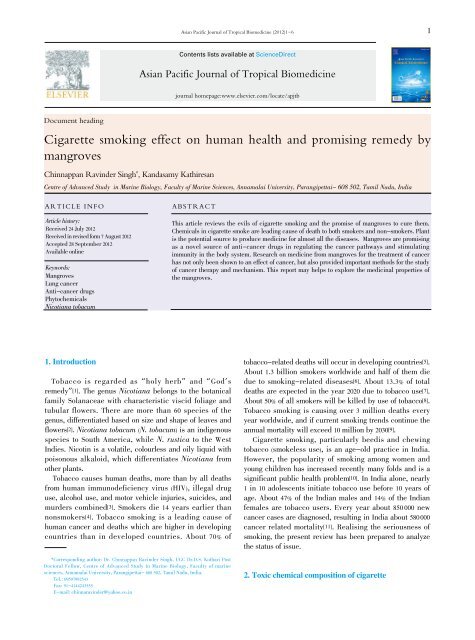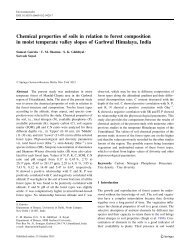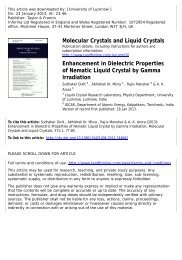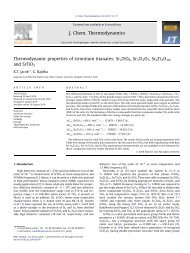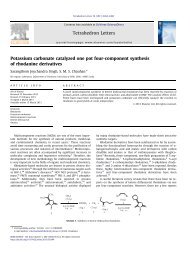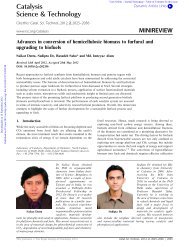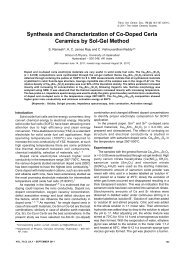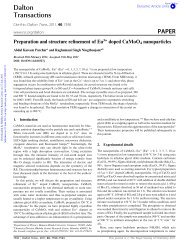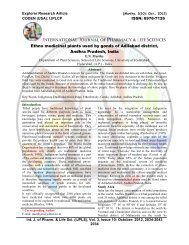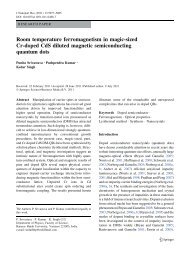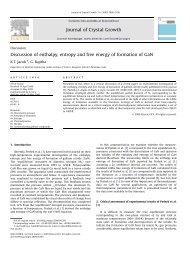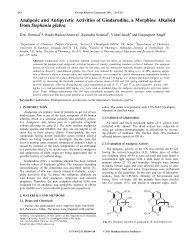Cigarette smoking effect on human health and ... - Dr. DS Kothari
Cigarette smoking effect on human health and ... - Dr. DS Kothari
Cigarette smoking effect on human health and ... - Dr. DS Kothari
Create successful ePaper yourself
Turn your PDF publications into a flip-book with our unique Google optimized e-Paper software.
Asian Pacific Journal of Tropical Biomedicine (2012)1-61C<strong>on</strong>tents lists available at ScienceDirectAsian Pacific Journal of Tropical Biomedicinejournal homepage:www.elsevier.com/locate/apjtbDocument heading<str<strong>on</strong>g>Cigarette</str<strong>on</strong>g> <str<strong>on</strong>g>smoking</str<strong>on</strong>g> <str<strong>on</strong>g>effect</str<strong>on</strong>g> <strong>on</strong> <strong>human</strong> <strong>health</strong> <strong>and</strong> promising remedy bymangrovesChinnappan Ravinder Singh * , K<strong>and</strong>asamy KathiresanCentre of Advanced Study in Marine Biology, Faculty of Marine Sciences, Annamalai University, Parangipettai- 608 502, Tamil Nadu, IndiaARTICLE INFOArticle history:Received 24 July 2012Received in revised form 7 August 2012Accepted 28 September 2012Available <strong>on</strong>lineKeywords:MangrovesLung cancerAnti-cancer drugsPhytochemicalsNicotiana tobacumABSTRACTThis article reviews the evils of cigarette <str<strong>on</strong>g>smoking</str<strong>on</strong>g> <strong>and</strong> the promise of mangroves to cure them.Chemicals in cigarette smoke are leading cause of death to both smokers <strong>and</strong> n<strong>on</strong>-smokers. Plantis the potential source to produce medicine for almost all the diseases. Mangroves are promisingas a novel source of anti-cancer drugs in regulating the cancer pathways <strong>and</strong> stimulatingimmunity in the body system. Research <strong>on</strong> medicine from mangroves for the treatment of cancerhas not <strong>on</strong>ly been shown to an <str<strong>on</strong>g>effect</str<strong>on</strong>g> of cancer, but also provided important methods for the studyof cancer therapy <strong>and</strong> mechanism. This report may helps to explore the medicinal properties ofthe mangroves.1. Introducti<strong>on</strong>Tobacco is regarded as “holy herb” <strong>and</strong> “God’sremedy”[1]. The genus Nicotiana bel<strong>on</strong>gs to the botanicalfamily Solanaceae with characteristic viscid foliage <strong>and</strong>tubular flowers. There are more than 60 species of thegenus, differentiated based <strong>on</strong> size <strong>and</strong> shape of leaves <strong>and</strong>flowers[2]. Nicotiana tobacum (N. tobacum) is an indigenousspecies to South America, while N. rustica to the WestIndies. Nicotin is a volatile, colourless <strong>and</strong> oily liquid withpois<strong>on</strong>ous alkaloid, which differentiates Nicotiana fromother plants.Tobacco causes <strong>human</strong> deaths, more than by all deathsfrom <strong>human</strong> immunodeficiency virus (HIV), illegal druguse, alcohol use, <strong>and</strong> motor vehicle injuries, suicides, <strong>and</strong>murders combined[3]. Smokers die 14 years earlier thann<strong>on</strong>smokers[4]. Tobacco <str<strong>on</strong>g>smoking</str<strong>on</strong>g> is a leading cause of<strong>human</strong> cancer <strong>and</strong> deaths which are higher in developingcountries than in developed countries. About 70% of*Corresp<strong>on</strong>ding author: <strong>Dr</strong>. Chinnappan Ravinder Singh, UGC <strong>Dr</strong>.D.S. <strong>Kothari</strong> PostDoctoral Fellow, Centre of Advanced Study in Marine Biology, Faculty of marinesciences, Annamalai University, Parangipettai- 608 502, Tamil Nadu, India.Tel.: 09597992543Fax: 91-4144243555E-mail: chinnaravinder@yahoo.co.intobacco-related deaths will occur in developing countries[5].About 1.3 billi<strong>on</strong> smokers worldwide <strong>and</strong> half of them diedue to <str<strong>on</strong>g>smoking</str<strong>on</strong>g>-related diseases[6]. About 13.3% of totaldeaths are expected in the year 2020 due to tobacco use[7].About 50% of all smokers will be killed by use of tobacco[8].Tobacco <str<strong>on</strong>g>smoking</str<strong>on</strong>g> is causing over 3 milli<strong>on</strong> deaths everyyear worldwide, <strong>and</strong> if current <str<strong>on</strong>g>smoking</str<strong>on</strong>g> trends c<strong>on</strong>tinue theannual mortality will exceed 10 milli<strong>on</strong> by 2030[9].<str<strong>on</strong>g>Cigarette</str<strong>on</strong>g> <str<strong>on</strong>g>smoking</str<strong>on</strong>g>, particularly beedis <strong>and</strong> chewingtobacco (smokeless use), is an age-old practice in India.However, the popularity of <str<strong>on</strong>g>smoking</str<strong>on</strong>g> am<strong>on</strong>g women <strong>and</strong>young children has increased recently many folds <strong>and</strong> is asignificant public <strong>health</strong> problem[10]. In India al<strong>on</strong>e, nearly1 in 10 adolescents initiate tobacco use before 10 years ofage. About 47% of the Indian males <strong>and</strong> 14% of the Indianfemales are tobacco users. Every year about 850 000 newcancer cases are diagnosed, resulting in India about 580 000cancer related mortality[11]. Realising the seriousness of<str<strong>on</strong>g>smoking</str<strong>on</strong>g>, the present review has been prepared to analyzethe status of issue.2. Toxic chemical compositi<strong>on</strong> of cigarette
2C. Ravinder Singh, K. Kathiresan./Asian Pacific Journal of Tropical Biomedicine (2012)1-6Tobacco is grown <strong>and</strong> sold in many countries. The largestproducers of tobacco are China, USA, the former SovietStates, Brazil <strong>and</strong> India. <str<strong>on</strong>g>Cigarette</str<strong>on</strong>g>s are made from driedleaves of the tobacco plant. The chemical compositi<strong>on</strong> oftobacco varies widely with different sites due to the diversityof climatic c<strong>on</strong>diti<strong>on</strong>s. Even within the same tobacco, thechemical compositi<strong>on</strong> of different leaves can be significantlydifferent[12]. Chlorophyll a <strong>and</strong> b, neoxanthin, violaxanthin,lutein <strong>and</strong> 毬 - carotene are also present in N. tobacum[13].After the leaves of the tobacco plant are harvested <strong>and</strong>dried, they are treated with many chemicals. <str<strong>on</strong>g>Cigarette</str<strong>on</strong>g>smoke c<strong>on</strong>tains over 4 000 different chemicals <strong>and</strong> many ofthem cause cancer[14,15]. The cigarette smoke c<strong>on</strong>tains blacksticky tar that c<strong>on</strong>tains toxic chemicals such as amm<strong>on</strong>ia,toluene <strong>and</strong> acet<strong>on</strong>e. Tar is the main cause of throat <strong>and</strong> lungcancer. It also causes the yellowish brown stains <strong>on</strong> fingers,teeth <strong>and</strong> lung tissue. Nicotine is the major drug found intobacco which c<strong>on</strong>tributes to addicti<strong>on</strong> to cigarette <str<strong>on</strong>g>smoking</str<strong>on</strong>g>which was first isolated from tobacco leaves as early as1828[16]. Nicotine has a number of harmful <str<strong>on</strong>g>effect</str<strong>on</strong>g>s <strong>on</strong> the<strong>human</strong> body in stimulating the nervous system, increasingheart beat, raising blood pressure <strong>and</strong> shrinking the smallblood vessels under the skin shrink, which can causewrinkles. Carb<strong>on</strong> m<strong>on</strong>oxide is a pois<strong>on</strong>ous gas that reducesthe amount of oxygen taken up by red blood cells. Hydrogencyanide damages the tiny hairs which act as natural lungcleaners of <strong>human</strong> bodies leading to accumulati<strong>on</strong> of toxicsubstances in the lungs. The toxic heavy metals found inthe cigarette smoke are: lead, nickel, arsenic <strong>and</strong> cadmium.Cancer-causing radioactive compounds are also found incigarettes. Pesticides like DDT <strong>and</strong> methoprene do presentin tobacco smoke which is used during tobacco cultivati<strong>on</strong>.Other chemicals such as benzene, creosote, <strong>and</strong> someasphalts cause skin cancer, lung cancer <strong>and</strong> reducti<strong>on</strong> inreproductive capacity. Am<strong>on</strong>g the 2 256 different smokecomp<strong>on</strong>ents, 542 find place in c<strong>on</strong>venti<strong>on</strong>al smoke by acigarette[17]. The highly carcinogenic compounds suchas dimethylbenz(a)anthracene, dimethylnitrosamine <strong>and</strong>methylnaphthalene are added when the cigarettes are beingmade[18].2.1. <str<strong>on</strong>g>Cigarette</str<strong>on</strong>g> <str<strong>on</strong>g>smoking</str<strong>on</strong>g> <strong>and</strong> cancerCancer-related death was estimated at 100 milli<strong>on</strong> in20th century <strong>and</strong> is 1 billi<strong>on</strong> in 21st century[19]. Cancerprevalence in the United States is about 300 cases per 100 000populati<strong>on</strong>s, whereas that in Asian countries is less than 100cases per 100 000 due to tobacco smoke[20]. It is estimatedthat in 2015, tobacco is projected to kill 50% more peoplethan HIV/AI<strong>DS</strong> <strong>and</strong> will be resp<strong>on</strong>sible for 10% of all deathsglobally[21]. Over 3 000 teenagers light up the cigarette for thefirst time every day[22]. In India, the Internati<strong>on</strong>al Agency forResearch <strong>on</strong> Cancer estimated that about 635 000 people diedfrom cancer in 2008, representing about 8% of all estimatedglobal cancer deaths <strong>and</strong> about 6% of all deaths in India[23].The temperature estimated at glowing tip of lighted cigaretteburning is 800 曟 . A smoker with each puff draws into hismouth <strong>and</strong> lungs, a hot collecti<strong>on</strong> of gases <strong>and</strong> many toxic1100 0001 000 000900 0001 020 000900 000800 000700 000600 000500 000500 000443 000400 000300 000200 000100 000140 000110 000ChinaIndiaRussiaAmericaGermanyTurktyUKPakistan100 00090 00066 00065 00050 000FranceMexicoSpainlran50 00049 00044 00040 000South KoreaSouth AfricaVietnamCanadaEgyptRomaniaNo.of deaths/year(in thous<strong>and</strong>s)Figure 1. Annual global death due to cigarette <str<strong>on</strong>g>smoking</str<strong>on</strong>g> related diseases.37 00034 00033 00020 00020 00019 00013 000PhillipinesGreeceAustraliaScotl<strong>and</strong>13 00010 0006 000CroatiaMalaysialrel<strong>and</strong>Cuba6 0005 0002 555New Zeal<strong>and</strong>Uruguay
C. Ravinder Singh, K. Kathiresan./Asian Pacific Journal of Tropical Biomedicine (2012)1-63particles[24]. Tobacco smoke may lead to changes in thelung tissue shortly after exposure, so called precancerouschanges. Tobacco-related cancers represent 11.45% malecancer deaths <strong>and</strong> there were twice as many deaths fromoral cancers as lung cancers in India[25]. Most of the lungcancer <strong>and</strong> emphysema, as well as a high percentage ofheart attacks are caused by cigarette <str<strong>on</strong>g>smoking</str<strong>on</strong>g>[26].Lung cancer is an aggressive <strong>and</strong> heterogeneous disease<strong>and</strong> most comm<strong>on</strong> malignant tumours worldwide[27-31]. Thelungs are the most important organs that help us breathe <strong>and</strong>give oxygen to all the cells in the body. These organs affectdirectly or indirectly by cigarette <str<strong>on</strong>g>smoking</str<strong>on</strong>g>. Like all cancers,lung cancer cells have the ability to invade neighboringtissues <strong>and</strong> spread to distant parts of the body. It is usuallyclassified as n<strong>on</strong>-small cell lung cancer (NSCLC), whichaccounts for more than 80% of lung cancers <strong>and</strong> it is the mostcomm<strong>on</strong> cause of cancer deaths worldwide[32,33]. In women,lung cancer is the third-most comm<strong>on</strong> cancer worldwide,after breast <strong>and</strong> colorectal cancers[34]. Smokers are 5-10times likely to develop lung cancer, about 87% of lungcancer cases are caused by cigarette <str<strong>on</strong>g>smoking</str<strong>on</strong>g>[35]. Every year,<strong>on</strong>e milli<strong>on</strong> smokers die of lung cancer in USA, accountingfor 25% of total <str<strong>on</strong>g>smoking</str<strong>on</strong>g>-related deaths (Figure 1). One in 10moderate smokers <strong>and</strong> <strong>on</strong>e in 5 heavy smokers (15 cigarettesper day) will die of lung cancer. About 85% of smokers withlung cancer die within 5.5 years die within <strong>on</strong>e year[36].Many types of cancers including pancreatic cancer <strong>and</strong>col<strong>on</strong> cancer, bladder <strong>and</strong> kidney cancer are caused dueto tobacco <str<strong>on</strong>g>smoking</str<strong>on</strong>g>[37]. Tobacco <str<strong>on</strong>g>smoking</str<strong>on</strong>g> is also associatedwith cancer of the oral cavity (including lip <strong>and</strong> t<strong>on</strong>gue) inboth men <strong>and</strong> women. <str<strong>on</strong>g>Cigarette</str<strong>on</strong>g> <str<strong>on</strong>g>smoking</str<strong>on</strong>g> causes not <strong>on</strong>lylung cancer, but also cancer in urinary tract, oral cavity,oropharynx <strong>and</strong> hypopharynx, oesophagus, larynx, pancreas,stomach, cervix, leukaemia, female breast <strong>and</strong> prostate[38].2.2. <str<strong>on</strong>g>Cigarette</str<strong>on</strong>g> <str<strong>on</strong>g>smoking</str<strong>on</strong>g> <strong>and</strong> <strong>human</strong> reproducti<strong>on</strong><str<strong>on</strong>g>Cigarette</str<strong>on</strong>g> <str<strong>on</strong>g>smoking</str<strong>on</strong>g> affects adversely <strong>human</strong> fertility[39].Chemical agents may affect male reproducti<strong>on</strong> by means ofdirect <str<strong>on</strong>g>effect</str<strong>on</strong>g> <strong>on</strong> the testicular functi<strong>on</strong> <strong>and</strong> spermatogenesis.The mechanisms involve the horm<strong>on</strong>al c<strong>on</strong>trol ofspermatogenesis or through direct <str<strong>on</strong>g>effect</str<strong>on</strong>g> up<strong>on</strong> the germcells <strong>and</strong> sertoli cells of the seminiferous epithelium. Suchalterati<strong>on</strong>s in the spermatogenetic capacity in the male maylead to infertility or producti<strong>on</strong> of mutated spermatozoawhich may subsequently cause poor pregnancy if themutated spermatozoa are to fertilize an egg. <str<strong>on</strong>g>Cigarette</str<strong>on</strong>g><str<strong>on</strong>g>smoking</str<strong>on</strong>g> causes different negative <str<strong>on</strong>g>effect</str<strong>on</strong>g>s <strong>on</strong> <strong>human</strong>reproductive process such as abnormal sperm morphology,less motile sperm, smaller quantity of sperm, lowerproporti<strong>on</strong> of normally shaped sperm <strong>and</strong> changes in thenumber <strong>and</strong> arrangement of the microtubules of the sperm ina smoker as compared to a n<strong>on</strong> smoker group of men[40-44].Women are likely to have menstrual irregularities,infertility problems, cramps <strong>and</strong> hot flashes duringmenopause due to <str<strong>on</strong>g>smoking</str<strong>on</strong>g>. Smoking lowers the level ofestrogen <strong>and</strong> attains early menopause with increased risk ofosteoporosis <strong>and</strong> fractures[45]. <str<strong>on</strong>g>Cigarette</str<strong>on</strong>g> <str<strong>on</strong>g>smoking</str<strong>on</strong>g> can interferewith almost every aspect of egg producti<strong>on</strong>, fertilizati<strong>on</strong>process, embryo attachment, growth <strong>and</strong> development of thebaby during the pregnancy. From the initial step of womanpregnancy, cigarette <str<strong>on</strong>g>smoking</str<strong>on</strong>g> causes a number of problemssuch as deleterious <str<strong>on</strong>g>effect</str<strong>on</strong>g>s <strong>on</strong> embryo transport, c<strong>on</strong>trol ofoocyte producti<strong>on</strong>, embryo viability, <strong>on</strong>set of menopause <strong>and</strong>b<strong>on</strong>e metabolism. The smoke affects both the mother <strong>and</strong>the growing young <strong>on</strong>es. The smoke adversely affects boththe humoral <strong>and</strong> cellular immune systems. Such alterati<strong>on</strong>smight affect epithelial resp<strong>on</strong>se to inflammati<strong>on</strong> result inan increased frequency of tubal infecti<strong>on</strong> <strong>and</strong> subsequentinfertility. Possible early or deferred entry of blastocystinto the uterus <strong>and</strong> alterati<strong>on</strong>s in the immune system thatcan account for the <str<strong>on</strong>g>smoking</str<strong>on</strong>g> <strong>and</strong> decreased fecundity[46,47].Exposure to cigarette smoke during pregnancy is associatedwith low birth weight, premature delivery, early pregnancyloss, prenatal mortality, <strong>and</strong> ectopic pregnancy[48].2.3. Other harmful <str<strong>on</strong>g>effect</str<strong>on</strong>g>s of cigarette <str<strong>on</strong>g>smoking</str<strong>on</strong>g><str<strong>on</strong>g>Cigarette</str<strong>on</strong>g> <str<strong>on</strong>g>smoking</str<strong>on</strong>g> c<strong>on</strong>tributes to remarkable risk factorsof n<strong>on</strong>-communicable diseases, including cor<strong>on</strong>ary heartdisease, stroke, chr<strong>on</strong>ic obstructive pulm<strong>on</strong>ary disease,peripheral vascular disease, peptic ulcer disease <strong>and</strong>tuberculosis[49]. <str<strong>on</strong>g>Cigarette</str<strong>on</strong>g> <str<strong>on</strong>g>smoking</str<strong>on</strong>g> is str<strong>on</strong>gly associated withlung cancer, emphysema, chr<strong>on</strong>ic br<strong>on</strong>chitis, cardiovasculardisease, <strong>and</strong> other serious internal diseases <strong>and</strong>cancers[50-54]. The n<strong>on</strong>-stop chr<strong>on</strong>ic inhalati<strong>on</strong> of cigarettesmoke alters a wide range of immunological functi<strong>on</strong>s,including innate <strong>and</strong> adaptive immune resp<strong>on</strong>ses[55].3. Envir<strong>on</strong>mental impact of cigarette <str<strong>on</strong>g>smoking</str<strong>on</strong>g>Smoking of cigarettes causes a great c<strong>on</strong>cern ofenvir<strong>on</strong>mental problems[56]. In the past 25 years, 52 907 756cigarette butts have been collected from internati<strong>on</strong>albeaches, accounting for 32% of all debris collected. Thenumber of cigarette butts collected is over three timesmore than that of other wastage[57]. These butts may thenbe carried as runoff to drains, making their way to rivers<strong>and</strong> ultimately to oceans. Though the waste materials arebiodegradable, it will take a l<strong>on</strong>g time of nine m<strong>on</strong>ths todegrade the cellulose acetate <strong>and</strong> plastic materials presentin the cigarette waste in the sewage water[58-60]. The studiesc<strong>on</strong>ducted in the aquatic ecosystems have reported that thenicotinic acid <strong>and</strong> ethyl phenol present in the cigarette buttsaffect the fish <strong>and</strong> microbial communities[61-63]. <str<strong>on</strong>g>Cigarette</str<strong>on</strong>g><str<strong>on</strong>g>smoking</str<strong>on</strong>g> releases about 2.6 billi<strong>on</strong> kilograms of carb<strong>on</strong>dioxide in the air every year <strong>and</strong> about 5.2 billi<strong>on</strong> kilogramsof methane annually worldwide[64,65].4. Mangroves in cancer treatmentThe plant kingdom is potentially a very diverse source of
4C. Ravinder Singh, K. Kathiresan./Asian Pacific Journal of Tropical Biomedicine (2012)1-6chemical c<strong>on</strong>stituents with many bioactivity notably tumourcytotoxic activity. India has the richest source of medicinalplants am<strong>on</strong>g the world. About 25 000 <str<strong>on</strong>g>effect</str<strong>on</strong>g>ive plant deriveddrugs are used in folk medicine in India. There are 7 800drug manufacturing units, which exploit about 2 000 t<strong>on</strong>nes ofherbal plants every year in the country[66]. Natural productshave played a significant role in drug discovery <strong>and</strong>development, especially as agents active against cancer <strong>and</strong>infectious diseases[67]. Several anticancer agents includingtaxol, vinblas-tine, vincristine, camptothecin derivatives,topotecan <strong>and</strong> irinotecan <strong>and</strong> etoposide are in clinical useall over the world[68].Traditi<strong>on</strong>al uses of mangroves recently attracted thescientific communities to find out the pharmaceuticalproducts to combat a number of serious diseases[69].Mangrove plants such as Avicennia africana, A. nitida,Bruguiera exaristate, Buddleja parviflora <strong>and</strong> Bruguierasexangula <strong>and</strong> some of the mangrove associates arealso used to cure the cancer diseases by the fishermencommunities[70,71]. The mangrove plants <strong>and</strong> their associatespossess a str<strong>on</strong>g antioxidant activity as they grow in thestressful envir<strong>on</strong>ment c<strong>on</strong>diti<strong>on</strong>s. Excoecaria agallocha,Avicennia alba, Aegiceras corniculatum, Bruguieragymnorrhiza, Ceriops dec<strong>and</strong>ra, Rhizophora mucr<strong>on</strong>ata,Rhizophora apiculata, Rhizophora stylosa, S<strong>on</strong>neratiaapetala, Acanthus ilicifolius, Ipomea pes-caprae, Sesuviumportulacastrum, Suaeda maritima, Heritiera fomes,Terminalia catappa <strong>and</strong> P<strong>and</strong>anus odoratissimu possessthe free radical scavenging <strong>and</strong> anti-oxidant activity[72-78].Mangrove plants are a rich source of steroids, triterpenes,sap<strong>on</strong>ins, flav<strong>on</strong>oids, alkaloids <strong>and</strong> tannins[79]. Naturalproducts with antitumour properties can be classifiedinto 13 distinct chemical groups such as alkaloids,phenylpropanoids, terpenoids, aldehydes, glycosides,lignans, lipids, unsap<strong>on</strong>ified lipids, nucleic acids,polysaccharides, proteins <strong>and</strong> unidentified compounds[80].About 32 plants, Acanthus ebracteatus, Acanthusillicifolius, Acrostichum aureum, Avicennia alba, Avicenniamarina, Barringt<strong>on</strong>ia asiatica, Bruguiera cylindrica,Bruguiera gymnorrhiza, Buddleja parviflora, Bruguierasexangula, Ceriops dec<strong>and</strong>ra, Ceriops tagal, Cissuscarnosa, Cordia cochinchinensis, Cynometra ramiflora,Derris trifoliata, Flagellaria indica, Lumnitzera racemosa,Nypa fruticans, Phoenix paludosa, Rhizophora apiculata,Rhizophora mucr<strong>on</strong>ata, Sarcolobus globosus, S<strong>on</strong>neratiaalba, S<strong>on</strong>neratia caseolaris, S. ovata, Stenochlaena palustris,Suaeda maritima, Trianthema dec<strong>and</strong>ra, Weddelia biflora,Xylocarpus granatum <strong>and</strong> Xylocarpus rumphii exhibit theantioxidant <strong>and</strong> cancer chemopreventi<strong>on</strong> activity[81]. In theyear of 2011, Kathiresan <strong>and</strong> his research team have provedanti-oral cancer <str<strong>on</strong>g>effect</str<strong>on</strong>g> of black tea extracted from themangrove plant Ceriops dec<strong>and</strong>ra[80]. Extracts of Bruguierasexangula bark are active against two tumours, Sarcoma180 <strong>and</strong> Lewis Lung carcinoma[82]. Twelve naphthoquin<strong>on</strong>esisolated from the mangrove Avicennia marina exhibit str<strong>on</strong>ganti-proliferative activities against L-929 mouse fibroblasts<strong>and</strong> K562 <strong>human</strong> chr<strong>on</strong>ic myeloid leukemia cell lines[83].Xylocarpus granatum, Aegiceras corniculatum, Calophylluminophyllum <strong>and</strong> Excoecaria agallocha display the str<strong>on</strong>ganti-proliferative <str<strong>on</strong>g>effect</str<strong>on</strong>g>[84].5. C<strong>on</strong>cluding remarksIt is matter of necessity to develop potent drugs to treat<str<strong>on</strong>g>smoking</str<strong>on</strong>g> related diseases. It is a matter of urgency toc<strong>on</strong>sider <str<strong>on</strong>g>effect</str<strong>on</strong>g>ive way for preventi<strong>on</strong> of smoke-relatedcancers. In this regard, plant bioactive compounds areimportant in the treatment of cancers. Natural productscomprise of 14 out of the top 35 drugs <strong>on</strong> worldwide sales[85].There are more than 270 000 higher plants existing <strong>on</strong> thisplanet including mangroves but <strong>on</strong>ly a small porti<strong>on</strong> hasbeen explored scientifically. So, it is anticipated thatplants can provide potential bioactive compounds for thedevelopment of new “leads” to combat cancer diseases.Finding remedy from natural sources is the <strong>on</strong>ly <str<strong>on</strong>g>effect</str<strong>on</strong>g>iveway to reduce the cancer diseases. In this regard, mangrovesare promising as a source of medicines. Further research iswarranted to develop potent drugs from the mangroves for<str<strong>on</strong>g>smoking</str<strong>on</strong>g>-related diseases in the following lines.Broad based screening of mangrove species extractedin different solvents of various polarities againstcarcinogenesis; isolati<strong>on</strong>, purificati<strong>on</strong> <strong>and</strong> identificati<strong>on</strong>of anti-cancer chemicals present in the potent extract;physical, chemical <strong>and</strong> biological characterizati<strong>on</strong>s of thebioactive compounds; formulati<strong>on</strong> of mangrove-based drugs<strong>and</strong> testing their efficacy with st<strong>and</strong>ard drugs under in vitro<strong>and</strong> in vivo c<strong>on</strong>diti<strong>on</strong>s; cost-benefits analysis for developingcommercial ventures.AcknowledgementsThe authors are thankful to the authority of AnnamalaiUniversity for providing facilities <strong>and</strong> <strong>Dr</strong>. C. Ravinder Singhto UGC for “UGC-<strong>Dr</strong>. <strong>DS</strong> <strong>Kothari</strong> Post Doctoral Fellowship”.References[1] Dicks<strong>on</strong> SA. Panacea or precious bane. Tobacco in 16th centuryliterature. New York: New York Public Library; 1954.[2] Feinh<strong>and</strong>ler SJ, Fleming HC, M<strong>on</strong>ahan JM. Pre-Columbiantobaccos in the Pacific. Ec<strong>on</strong>omic Botany 1979; 33: 213-226.[3] McGinnis J, Foege WH. Actual causes of death in the UnitedStates. J Am Med Assoc 1993; 270: 2207-2212.[4] Centers for Disease C<strong>on</strong>trol <strong>and</strong> Preventi<strong>on</strong>. Annual <str<strong>on</strong>g>smoking</str<strong>on</strong>g>attributablemortality, years of potential life lost, <strong>and</strong> ec<strong>on</strong>omiccosts—United States, 1995-1999. Morbid Mortal Weekly Report2002; 51: 300-303.[5] Jemal A, Center MM, DeSantis C, Ward EM. Global patternsof cancer incidence <strong>and</strong> mortality rates <strong>and</strong> trends. CancerEpidemiol Biomark Prevent 2010; 19: 1893-1907.
C. Ravinder Singh, K. Kathiresan./Asian Pacific Journal of Tropical Biomedicine (2012)1-65[6] World Health Organizati<strong>on</strong>. Global Youth Tobacco Survey.[Online]Available from: http://www.who.int/ tobacco/surveillance/gyts/en/index.html [Accessed 26th March, 2007].[7] Reddy SK, Gupta PC. Report <strong>on</strong> tobacco c<strong>on</strong>trol in India. NewDelhi: Shree Om Enterprises; 2004.[8] Peto R, Lopez AD, Boreham J, Thun M, Heath C, Doll R. Mortalityfrom <str<strong>on</strong>g>smoking</str<strong>on</strong>g> worldwide. Brit Med Bull 1996; 52: 12-21.[9] Gupta PC. Tobacco c<strong>on</strong>trol in India. Ind J Med Res 2006; 123:579-582.[10] Sinha DN, Reddy KS, Rahman K, Warren CW, J<strong>on</strong>es NR, AsmaS. Linking global youth tobacco survey (GYTS) data to the WHOframework c<strong>on</strong>venti<strong>on</strong> <strong>on</strong> tobacco c<strong>on</strong>trol: the case for India.Indian J Pub Health 2006; 50: 76-89.[11] McClure WF. Spectral characteristics of tobacco in the nearinfrared regi<strong>on</strong> from 0.6 to 2.6 micr<strong>on</strong>s. Tobac Sci 1968; 12:232-235.[12] Burt<strong>on</strong> HR, Kasperbauer MJ. Changes in chemical compositi<strong>on</strong>of Tobacco Lamina during senescence <strong>and</strong> curing. J Agric FoodChem 1985; 33(5): 879-883.[13] Hoffmann D, Hoffmann I, El Bayoumy K. The less harmfulcigarette: a c<strong>on</strong>troversial issue. A tribute to Ernst L Wynder.Chem Res Toxicol 2001; 14: 767-790.[14] Anne Charlt<strong>on</strong>. Medicinal uses of tobacco in history. J R Soc Med2004; 97: 292-296.[15] Posselt W, Reimann L. Chemische untersuchungen des tabaksund darstellung des eigenhumlichen wirksamen. Principes dieserpflanze. Geigers Mag Pharm1828; 24: 138-161.[16] Reinskje T, Thomas S, Ewa Florek JVB, Piet W, Anto<strong>on</strong> O.Hazardous compounds in tobacco smoke. Int J Envir Res PubHealth 2011; 8: 613-628.[17] World <strong>health</strong> Organizati<strong>on</strong>. IARC m<strong>on</strong>ographs <strong>on</strong> the evaluati<strong>on</strong> ofcarcinogenic risks to <strong>human</strong>s. Internati<strong>on</strong>al Agency for Research<strong>on</strong> Cancer; 2002, p. 83.[18] Doll RR, Peto K, Wheatley RG, Sutherl<strong>and</strong> I. Mortality in relati<strong>on</strong>to <str<strong>on</strong>g>smoking</str<strong>on</strong>g>: 40 years’ observati<strong>on</strong> <strong>on</strong> male British doctors. BritMed J 1994; 309: 901-911.[19] Garodia P, Ichikawa H, Malani N, Sethi G, Aggarwal BB. Fromancient medicine to modern medicine: Ayurvedic c<strong>on</strong>cepts of<strong>health</strong> <strong>and</strong> their role in inflammati<strong>on</strong> <strong>and</strong> cancer. J Soc IntegOncol 2007; 5: 1-16.[20] U.S. Department of Health <strong>and</strong> Human Services. Preventingtobacco use am<strong>on</strong>g young people: A report of the surge<strong>on</strong> general.Atlanta, GA: U.S. Public Health Service; 1994.[21] Mathers CD, L<strong>on</strong>car D. Projecti<strong>on</strong>s of global mortality <strong>and</strong> burdenof disease from 2002 to 2030. PLoS Med 2006; 3: 442.[22] Ferlay J, Shin HR, Bray F, Forman D, Mathers C, Parkin D.Estimates of worldwide burden of cancer in 2008. Int J Cancer2010; 127: 2893-2917.[23] Rajesj PD, Garrima M, Sharayu M, Yeole BB. Epidemologicalreview of gastric cancer in India. Indian J Med Paediatr Oncol2011; 32(1): 3-11.[24] Jiloha RC. Biological basis of tobacco addicti<strong>on</strong>: Implicati<strong>on</strong>s for<str<strong>on</strong>g>smoking</str<strong>on</strong>g>-cessati<strong>on</strong> treatment. Ind J Psych 2010; 52(4): 301-307.[25] World Cancer Research Fund, American Institute for CancerResearch. Food, nutriti<strong>on</strong> <strong>and</strong> the preventi<strong>on</strong> of cancer: a globalperspective. Washingt<strong>on</strong> DC: American Institute for CancerResearch; 1997, p. 37-145.[26] Parkin DM, Bray F, Ferlay J, Paola P. Estimating the world cancerburden: Globocan 2000. Int J Cancer 2001; 94: 153-156.[27] Bray F, Sankila R, Ferlay J, Parkin DM. Estimates of cancerincidence <strong>and</strong> mortality in Europe in 1995. Eur J Cancer 2002; 38:99-166.[28] Ding L, Getz G, Wheeler DA. Somatic mutati<strong>on</strong>s affect keypathways in lung adenocarcinoma. Nature 2008; 455: 1069-1075.[29] S<strong>and</strong>ers HR, Albitar M. Somatic mutati<strong>on</strong>s of signaling genes inn<strong>on</strong>-small cell lung cancer. Cancer Genet Cytogenet 2010; 203:7-15.[30] Burris HA. Shortcomings of current therapies for n<strong>on</strong>-small-celllung cancer: unmet medical needs. Oncogene 2009; 28: 4-13.[31] Toyooka S, Toyooka KO, Maruyama R. DNA methylati<strong>on</strong> profilesof lung tumors. Mol Cancer Therap 2001; 1: 61-67.[32] Ancuceanu RV. Pharmacologically active natural compounds forlung cancer. Altern Med Rev 2004; 9(4): 402-419.[33] American Cancer Society. 2001 tobacco use. In: American CancerSociety. Cancer facts <strong>and</strong> figures 2001. Atlanta, GA: AmericanCancer Society; 2004, p. 29-32.[34] Jemal A, Thomas A, Murray T, Thun M. Cancer statistics, 2002.Cancer J Clin 2002; 52: 23-47.[35] Maurya V, Vijayan VK, Shah A. Smoking <strong>and</strong> tuberculosis: Anassociati<strong>on</strong> overlooked. Int J Tuberc Lung Dis 2002; 6: 942-951.[36] Robert NP. Tobacco <strong>and</strong> the global lung cancer epidemic. NatureRev 2001; 1: 82-86.[37] Panayiotis M, Zavos PN, Zarmakoupis-Zavos A. Impact ofcigarette <str<strong>on</strong>g>smoking</str<strong>on</strong>g> <strong>on</strong> <strong>human</strong> reproducti<strong>on</strong>: its <str<strong>on</strong>g>effect</str<strong>on</strong>g>s <strong>on</strong> male <strong>and</strong>female fecundity. Technology 1999; 6: 9-16.[38] Evans JH, Fletcher J, Torrance M, Hargreave TB. Spermabnormalities <strong>and</strong> cigarette <str<strong>on</strong>g>smoking</str<strong>on</strong>g>. Lancet 1986; 1: 627.[39] H<strong>and</strong>elsman DJ, C<strong>on</strong>way AJ, Boylan LM, Turtle JR. Testicularfuncti<strong>on</strong> in potential sperm d<strong>on</strong>ors: Normal ranges <strong>and</strong> the <str<strong>on</strong>g>effect</str<strong>on</strong>g>sof <str<strong>on</strong>g>smoking</str<strong>on</strong>g> <strong>and</strong> varicocele. Int J Androl 1984; 7: 369.[40] Karagounis CS, Papanikolaou NA, Zavos PM. Semen parameterscompared between <str<strong>on</strong>g>smoking</str<strong>on</strong>g> <strong>and</strong> n<strong>on</strong><str<strong>on</strong>g>smoking</str<strong>on</strong>g> men: Smokingintensity <strong>and</strong> semen parameters. Infertility 1985; 8: 373.[41] Vogt HJ, Heller WD, Borelli S. Sperm quality of <strong>health</strong>y smokers,ex-smokers, <strong>and</strong> never-smokers. Fertil Steril 1986; 45: 106.[42] Zavos PM, Correa JR, Karagounis CS, Ahparaki A, Foroglou CR,Hicks CL, et al. An electr<strong>on</strong> microscope study of the an<strong>on</strong>emalultra structure in <strong>human</strong> spermatozoa from male smokers <strong>and</strong>n<strong>on</strong>smokers. Fertil Steril 1998; 69(3): 103.[43] Lodrup Carles KC, Jaakkola JJ, Nafstad P, Carlsen KH. In uteroexposure to cigarette <str<strong>on</strong>g>smoking</str<strong>on</strong>g> influences lung functi<strong>on</strong> at birth.Eur Respir J 1997; 10(8): 1774-1779.[44] Usha Saha. Tobacco interventi<strong>on</strong>s <strong>and</strong> anaesthesia-A review.Indian J Anaesth 2009; 53(5): 618-627.[45] Burt<strong>on</strong> RC. Smoking, immunity <strong>and</strong> cancer. Med J Austr 1983; 5:411.[46] Shiverick KT, Salafia C. <str<strong>on</strong>g>Cigarette</str<strong>on</strong>g> <str<strong>on</strong>g>smoking</str<strong>on</strong>g> <strong>and</strong> pregnancy I:Ovarian, uterine <strong>and</strong> placental <str<strong>on</strong>g>effect</str<strong>on</strong>g>s. Placent 1999; 20: 265-272.[47] Rose JE. Nicotine addicti<strong>on</strong> <strong>and</strong> treatment. Annual Rev Med 1996;41: 493-507.[48] S<strong>on</strong>nenfeld G, Hudgens RW. Effect of carcinogenic comp<strong>on</strong>entsof cigarette smoke <strong>on</strong> in vivo producti<strong>on</strong> of murine interfer<strong>on</strong>.
6C. Ravinder Singh, K. Kathiresan./Asian Pacific Journal of Tropical Biomedicine (2012)1-6Cancer Research 1983; 43(10): 4720-4722.[49] Bartsch H, Malaveille C, Friesen M, Kadlubar FF, Vineis P.Black (air-cured) <strong>and</strong> bl<strong>on</strong>d (flue-cured) tobacco cancer risk.IV: molecular dosimetry studies implicate aromatic amines asbladder carcinogens. Eur J Cancer 1993; 29(8): 1199-1207.[50] Penn A, Chen LC, Snyder CA. Inhalati<strong>on</strong> of steady-statesidestream smoke from <strong>on</strong>e cigarette promotes arterioscleroticplaque development. Circulati<strong>on</strong> 1994; 90(3): 1363-1367.[51] Stefanadis C, Tsiamis E, Vlachopoulos C, Stratos C, Toutouzas K,Pitsavos C. Unfavorable <str<strong>on</strong>g>effect</str<strong>on</strong>g> of <str<strong>on</strong>g>smoking</str<strong>on</strong>g> <strong>on</strong> the elastic propertiesof the <strong>human</strong> aorta. Circulati<strong>on</strong> 1997; 95(1): 31-38.[52] Schafer T, Dirsched P, Kunz B, Ring J, Uberla K. Maternal<str<strong>on</strong>g>smoking</str<strong>on</strong>g> during pregnancy <strong>and</strong> lactati<strong>on</strong> increases the risk foratopic eczema in the offspring. J Am Acad Dermatol 1997; 36(4):550-556.[53] Holt PG, Keast D. Envir<strong>on</strong>mentally induced changes inimmunological functi<strong>on</strong>: acute <strong>and</strong> chr<strong>on</strong>ic <str<strong>on</strong>g>effect</str<strong>on</strong>g>s of inhalati<strong>on</strong> oftobacco smoke <strong>and</strong> other atmospheric c<strong>on</strong>taminants in man <strong>and</strong>experimental animals. Bacteriol Rev 1977; 41: 205-216.[54] Curnow RC, Spehr KL. Littering behaviour studies: Measuringenvir<strong>on</strong>mentally desirable behaviour. NSW; 2001.[55] Internati<strong>on</strong>al coastal cleanup. Report (ocean c<strong>on</strong>servancy):tracking trash-25 years of acti<strong>on</strong> for the ocean. Washingt<strong>on</strong>, DC;2011.[56] Ishigaki T, Sugano W, Nakanishi A, Tateda M, Ike M, FujitaM. The degradability of biodegradable plastics in aerobic <strong>and</strong>anaerobic waste l<strong>and</strong>fill model reactors. Chemosphere 2004; 54(3):225-233.[57] Register K. <str<strong>on</strong>g>Cigarette</str<strong>on</strong>g> butts as litter-toxic as well as ugly.Underwater Naturalist. Bull Am Litt Soc 2000; 5(2).[58] Micevska T, Warne MS, Pablo F, Patra R. Variati<strong>on</strong> in, <strong>and</strong> causesof, toxicity of cigarette butts to a cladoceran <strong>and</strong> microtox. ArchEnvir C<strong>on</strong>tam Toxic 2006; 50(2): 205-212.[59] Slaughter E, Gersberg R, Watanabe K, Rudolph J, Novotny TE.Toxicity of cigarette butts, <strong>and</strong> their chemical comp<strong>on</strong>ents, tomarine <strong>and</strong> freshwater fish. Tobac C<strong>on</strong>trol 2011; 20: 23-27.[60] Novotny T, Zhao F. C<strong>on</strong>sumpti<strong>on</strong> <strong>and</strong> producti<strong>on</strong> waste: anotherexternality of tobacco use. TobacC<strong>on</strong>trol 1999; 8: 75-80.[61] Leistikow BN, Martin DC, Milano CE. Estimates of <str<strong>on</strong>g>smoking</str<strong>on</strong>g>attributabledeaths at ages 15-54, motherless or fatherless youths,<strong>and</strong> resulting social security costs in the United States in 1994.Prevent Med 2000; 30(5): 353-360.[62] Verma S, Singh SP. Current <strong>and</strong> future status of herbal medicines.Veterin World 2008; 1(11): 347-350.[63] Butler MS. Natural products to drugs: natural product-derivedcompounds in clinical trials. Nat Prod Report 2008; 25: 475-516.[64] Mohammad Shoeb A. Anticancer agents from medicinal plants,Bangladesh. J Pharm 2006; 1: 35-41.[65] Patra JK. Metabolic diversity <strong>and</strong> bioactivity screening ofmangrove plants: A review. Act Physiol Plant 2011; 33: 1051-1061.[66] Taylor JLS, Rabe T, McGaw LJ, Jager AK, van Staden J. Towardsthe scientific validati<strong>on</strong> of traditi<strong>on</strong>al medicinal plants. PlantGrowth Regulat 2001; 34(1): 23-37.[67] Kathiresan K. Book review: Atlas of mangrove wetl<strong>and</strong>s of India.Curr Sci 2005; 88(1): 182-183.[68] J<strong>on</strong>g TT, Chau SW. Antioxidative activity of c<strong>on</strong>stituents isolatedfrom P<strong>and</strong>anus odoratissimus. Phytochemistry 1998; 49: 2145-2148.[69] Lin CC, Hsu YF, Lin TC. Effect of punicalin <strong>on</strong> Carrageenaninduced inflammati<strong>on</strong> in rat. Am J Chin Med 1999; 27: 371-376.[70] Masuda T, Y<strong>on</strong>emori S, Oyama Y, Takeda Y, Takana S, et al.Evaluati<strong>on</strong> of the antioxidants activity of envir<strong>on</strong>mental plants. JAgric Food Chem 1999; 47: 1749-1754.[71] Chen PS, Li JH, Liu TY, Lin TC. Folk medicine Terminaliacatappa <strong>and</strong> its major Terminalia catappa <strong>and</strong> its major tannincomp<strong>on</strong>ent Punicalagin are <str<strong>on</strong>g>effect</str<strong>on</strong>g>ive against belomycin-inducedgenotoxicity in Chinese hamster ovary cells. Cancer Letter 2000;152: 371-376.[72] Li DL, Li XM, Peng ZY, Wang BG. Flavanol derivatives fromRhizophora stylosa <strong>and</strong> their DPPH radical scavenging activity.Molecules 2007; 12: 1163-1169.[73] Banerjee D, Chakrabarti S, Hazra AK, Banerjee S, Ray J, MukerjeeB. Antioxidant activity <strong>and</strong> total phenolic of some mangrove inSunderbans. Afric J Biotechnol 2008; 7(6): 805-810.[74] Wangensteen H, Alamgir M, Du<strong>on</strong>g GM, Gr<strong>on</strong>haug TE, SamuelsenAB, Malterud KE. Chemical <strong>and</strong> biological studies of medicinalplants from the Sundarbans mangrove forest. Adv Phytother Res2009; 1: 59-78.[75] Boopathy NS, Kathiresan K, Manivannan S, Je<strong>on</strong> You-jinY. Effect of mangrove tea extract from Ceriops dec<strong>and</strong>ra <strong>on</strong>salivary bacterial flora of DMBA induced hamster buccal pouchcarcinoma. J Oncol 2011; 1-7.[76] Bunyapraphatsara N, Jutivibo<strong>on</strong>suk A, Sornlek P, HerathanathornW, Aksornkaew S, F<strong>on</strong>g HHS, et al. Pharmacological studies ofplants in the mangrove forest, Thai. J Phytopharm 2003; 10(2):2-12.[77] Loder JW, Russell GB. Tumour inhibitory plants. The alkaloids ofBruguiera sexangula <strong>and</strong> Bruguiera exaristata (Rhizophoraceae).Austr J Chem 1969; 22: 1271-1275.[78] B<strong>and</strong>aranyake WM. Survey of mangrove plants from NorthernAustralia for phytochemical c<strong>on</strong>stituents <strong>and</strong> UV-absorbingcompounds. Curr Topics Phytochem 1995; 14: 69-78.[79] Han L, Huang X, Dahse HM, Moellmann U, Fu H, et al. Unusualnaphthoquin<strong>on</strong>e derivatives from the twigs of Avicennia marina. JNat Product 2007; 70: 923-927.[80] Trapp S, Croteau R. Defensive resian biosynthesis in c<strong>on</strong>ifers.Annual Rev Plant Physiol Plant Mol Biol 2001; 52: 1526-1532.[81] Uddin SJ, Nahar L, Shilpi JA, Shoeb M, Borkowski T, Gibb<strong>on</strong>s S,et al. Gedunin, a lim<strong>on</strong>oid from Xylocarpus granatum, inhibitsthe growth of CaCO 2 col<strong>on</strong> cancer cell line in vitro. Phytother Res2007; 21(8): 757-761.[82] Xu M, Cui J, Fu H, Proksch P, Lin W, Li M. Embelin derivatives<strong>and</strong> their anticancer activity through microtubule disassembly.Plant Med 2005; 71: 944-948.[83] K<strong>on</strong>oshim T, K<strong>on</strong>ishi T, Takasaki M, Yamazoe K, Tokuda H.Anti-tumor-promoting activity of the diterpene from Excoecariaagallocha II. Biol Pharm Bull 2001; 24: 1440-1442.[84] Beebe-Dimmer JL, Wood DP, Gruber SB, Dougla JA, B<strong>on</strong>ner JD,Mohai C, et al. Use of complementary <strong>and</strong> alternative medicine inmen with family history of prostate cancer: a pilot study. J Urol2004; 63(2): 282-287.[85] Butlet MS. The role of natural product chemistry in drugdiscovery. Nat Product Report 2004; 67: 2141-2153.


